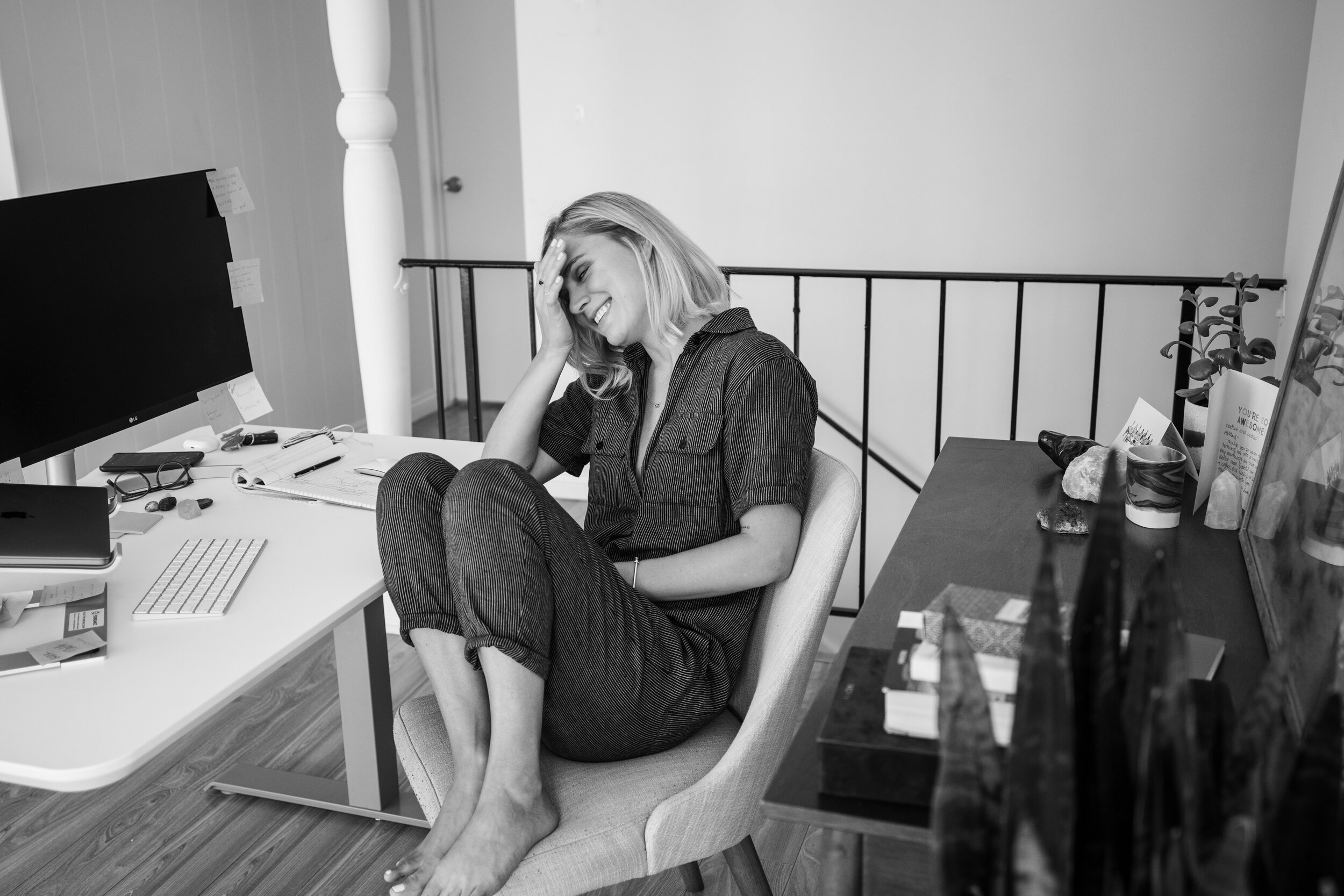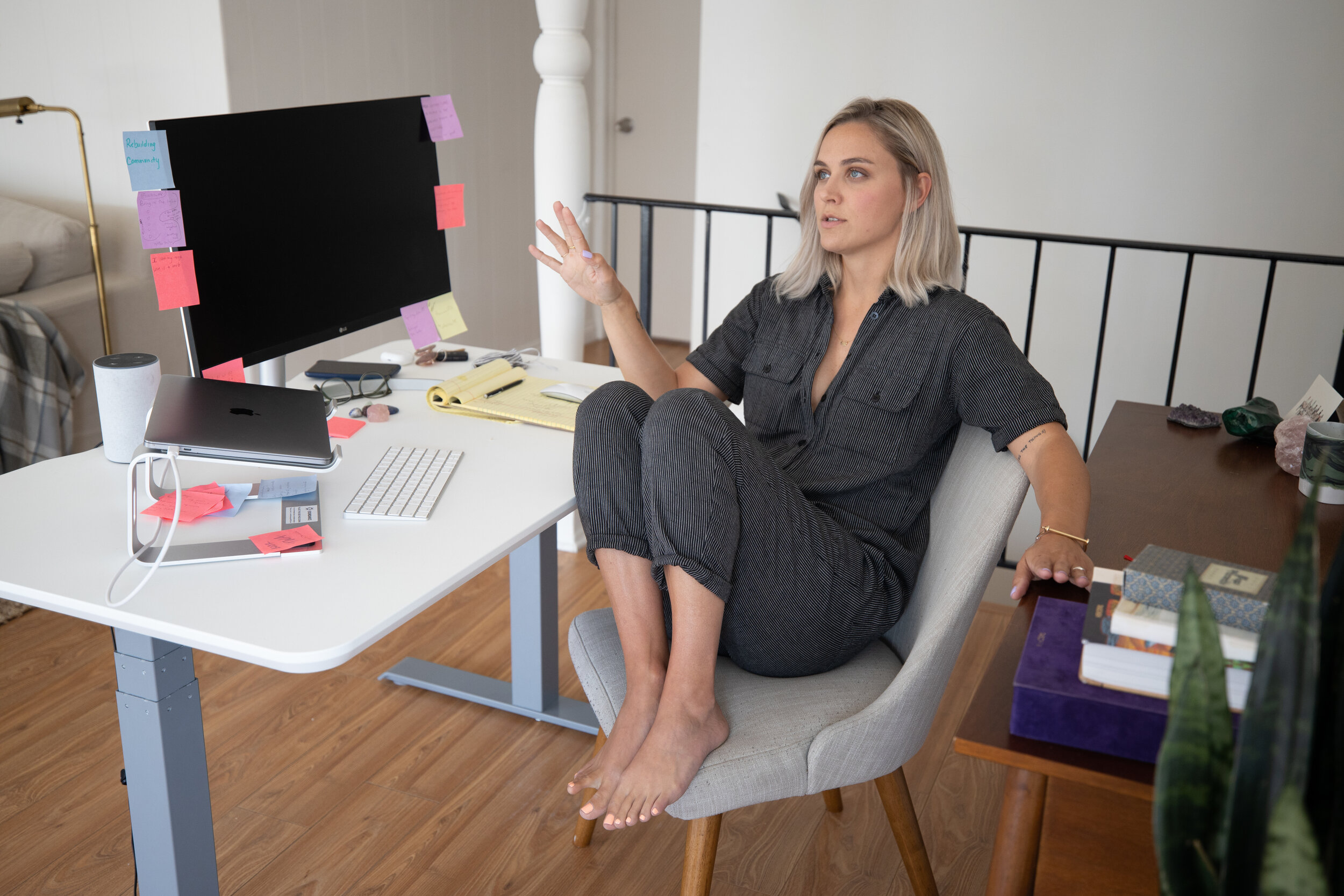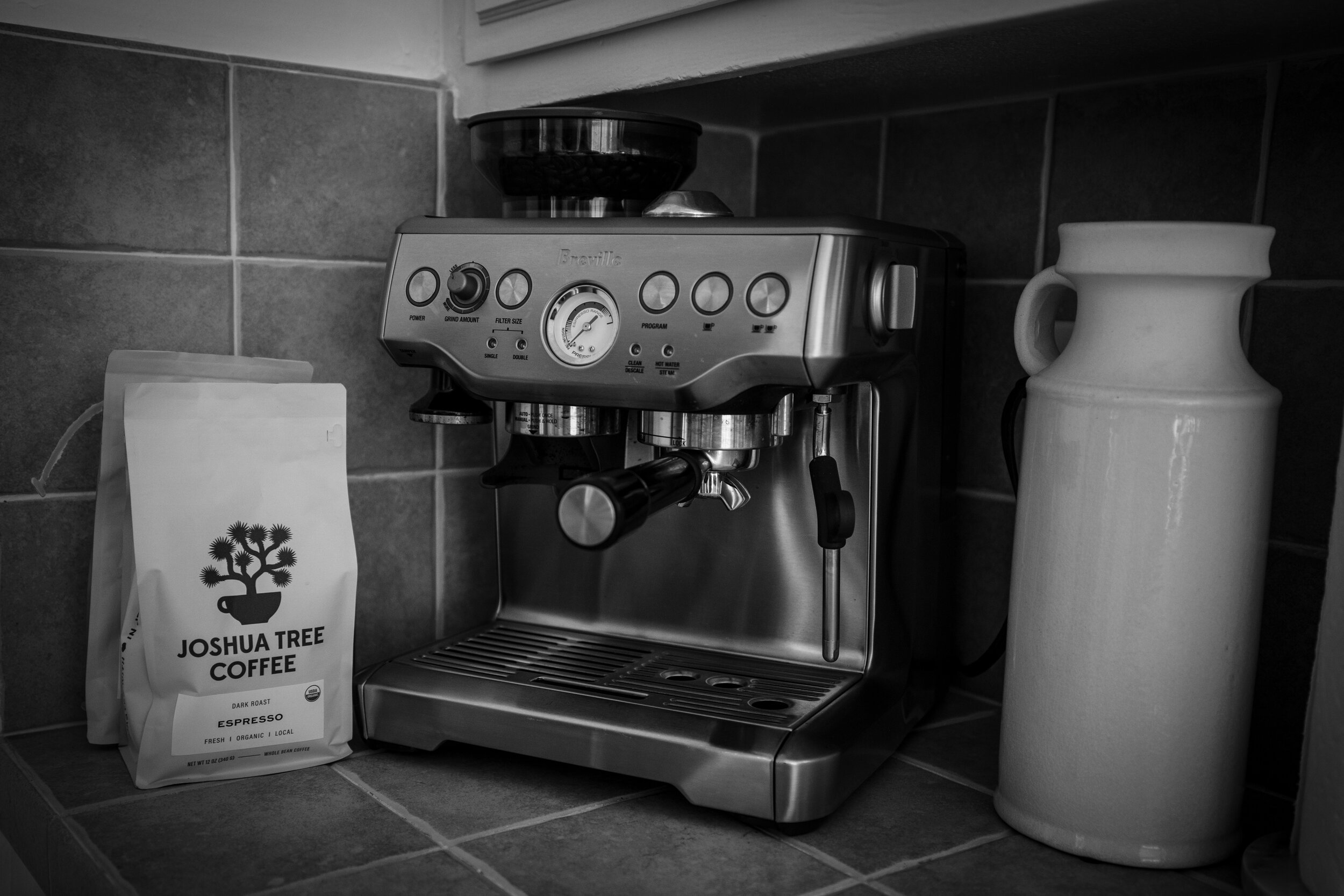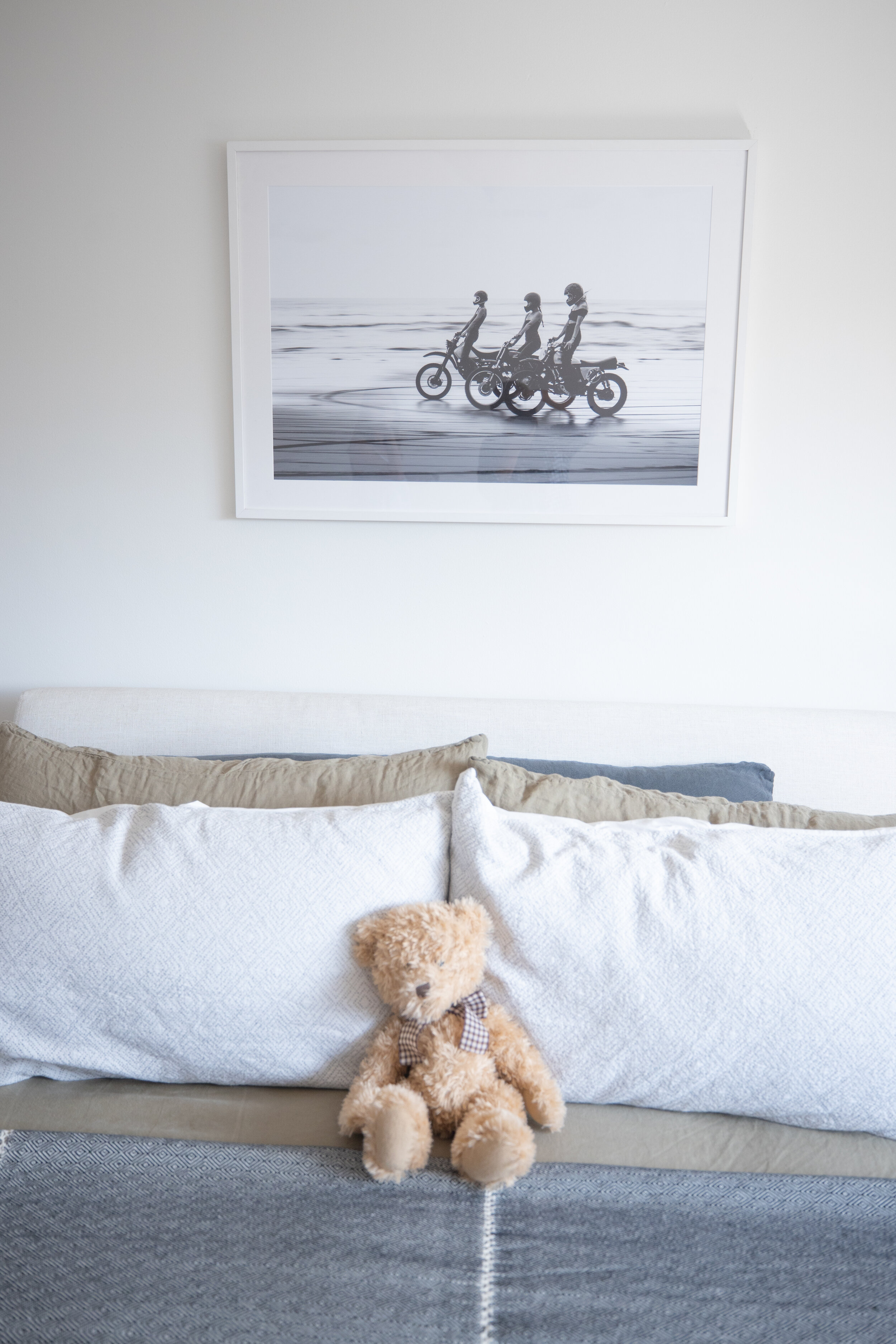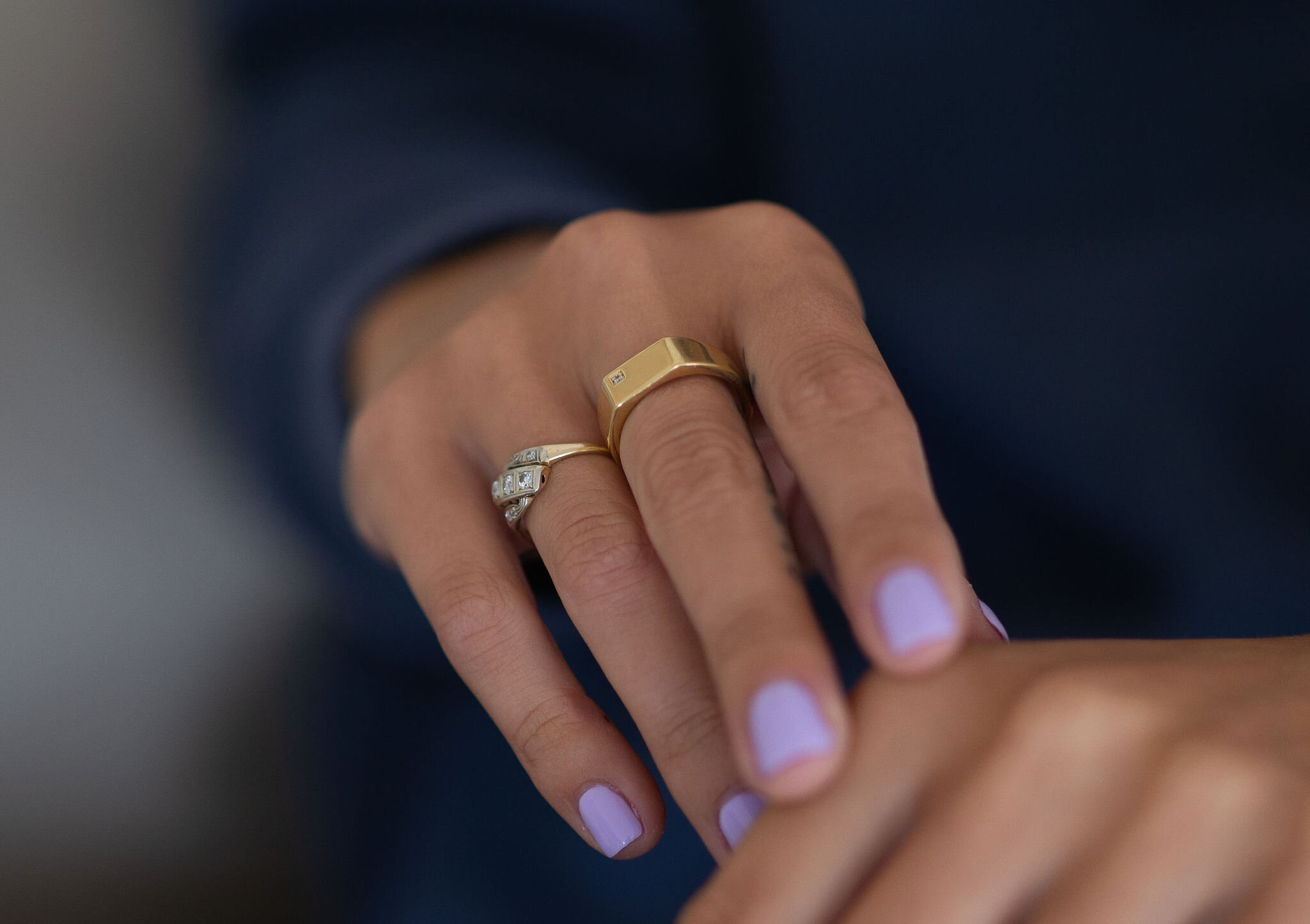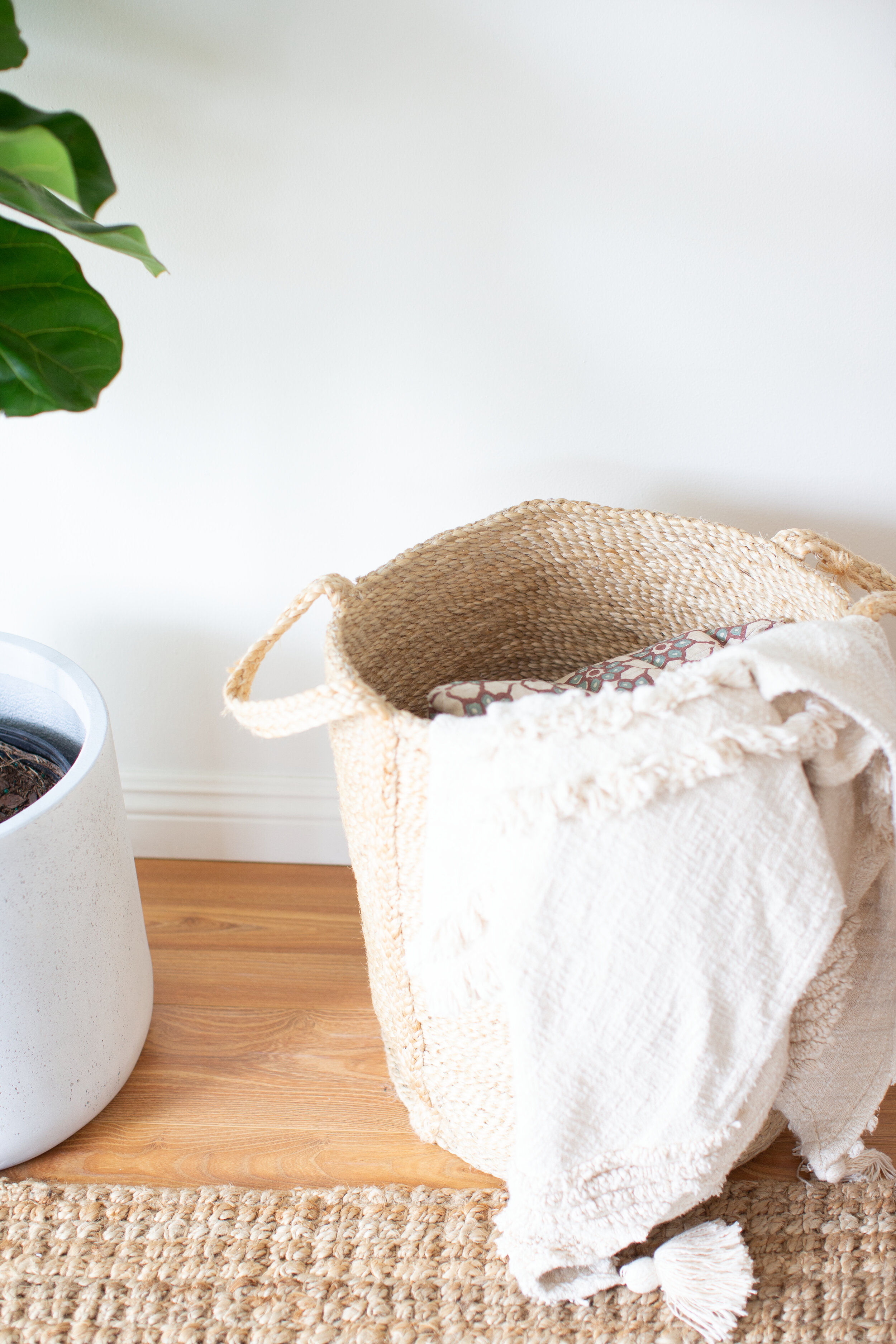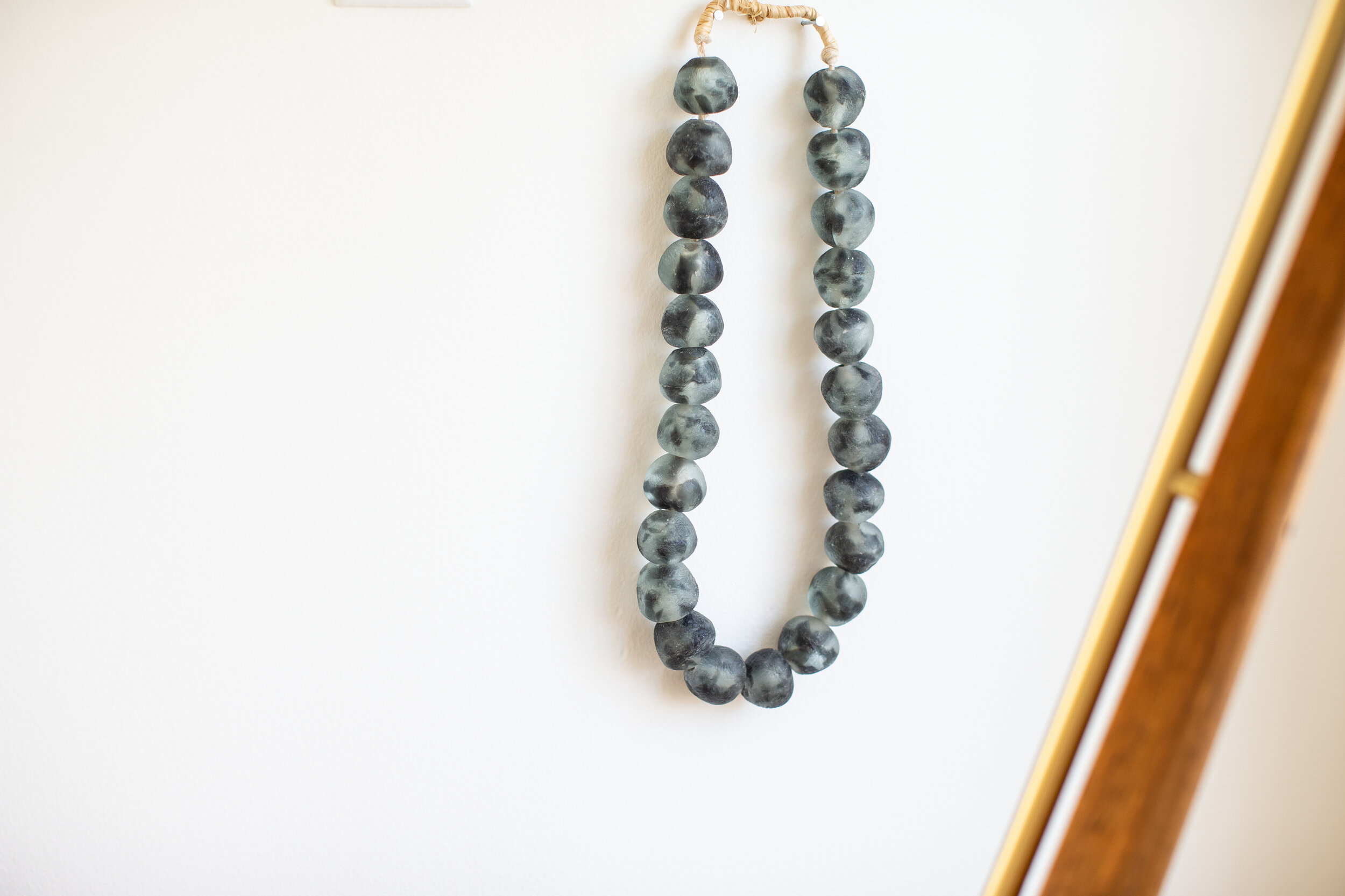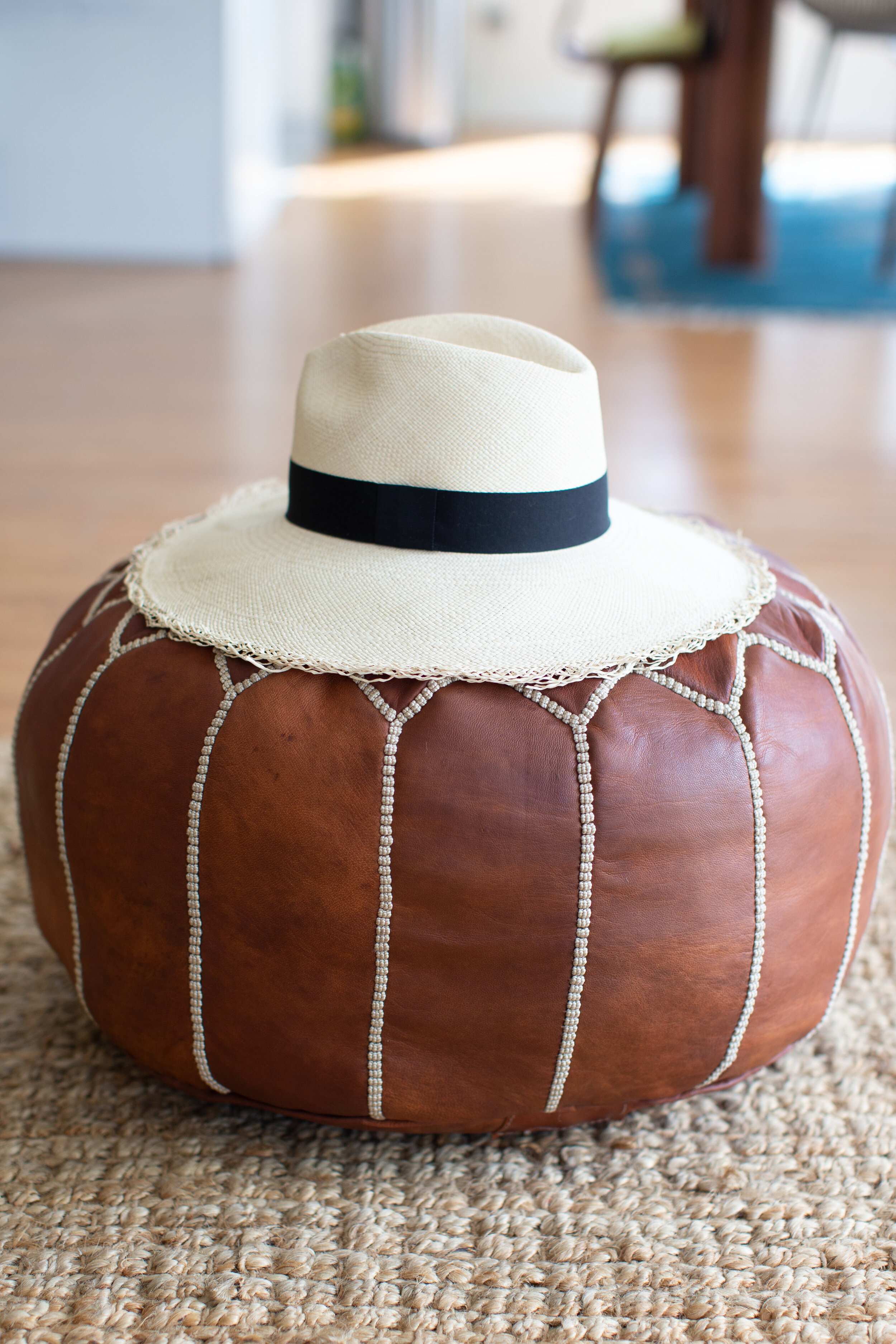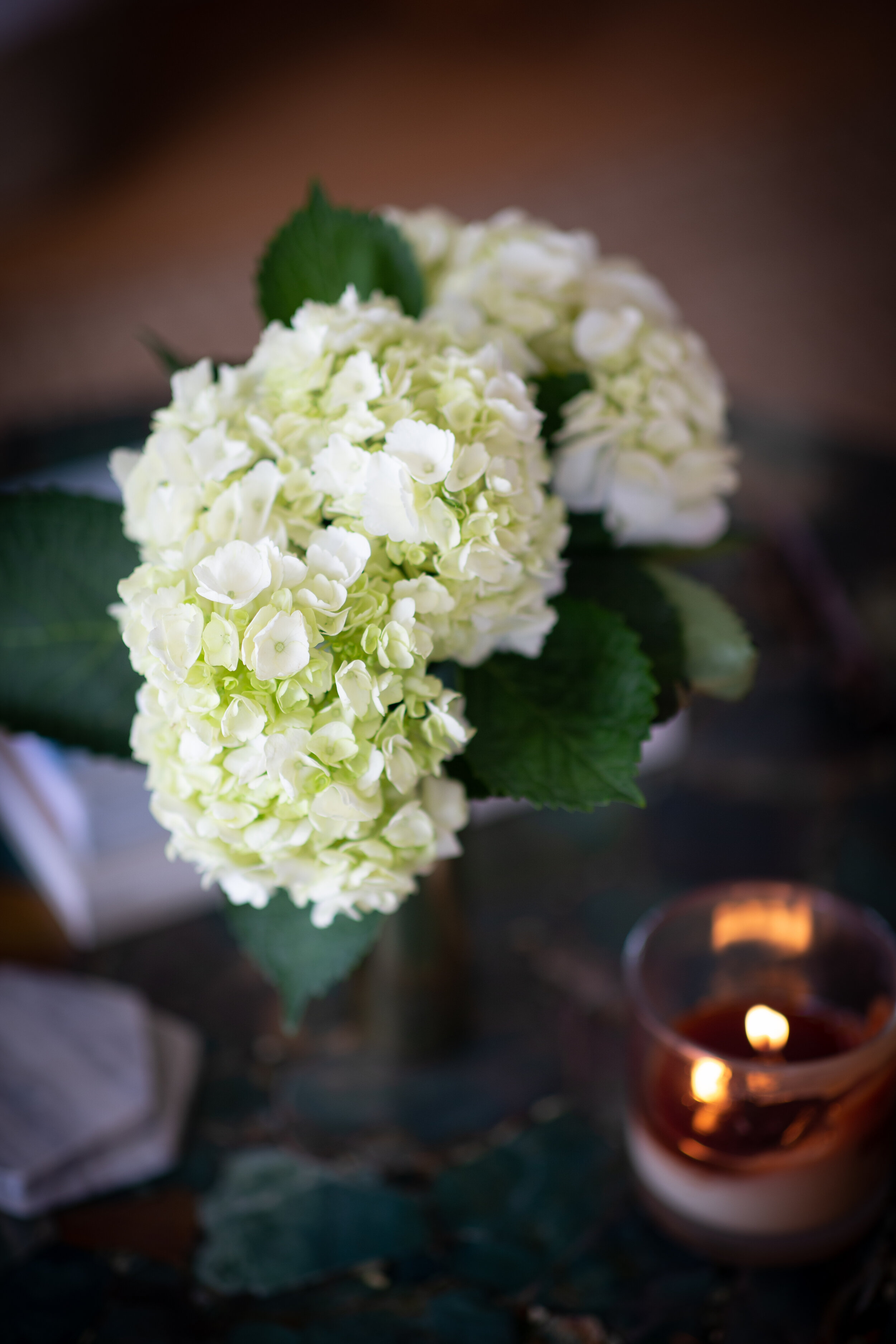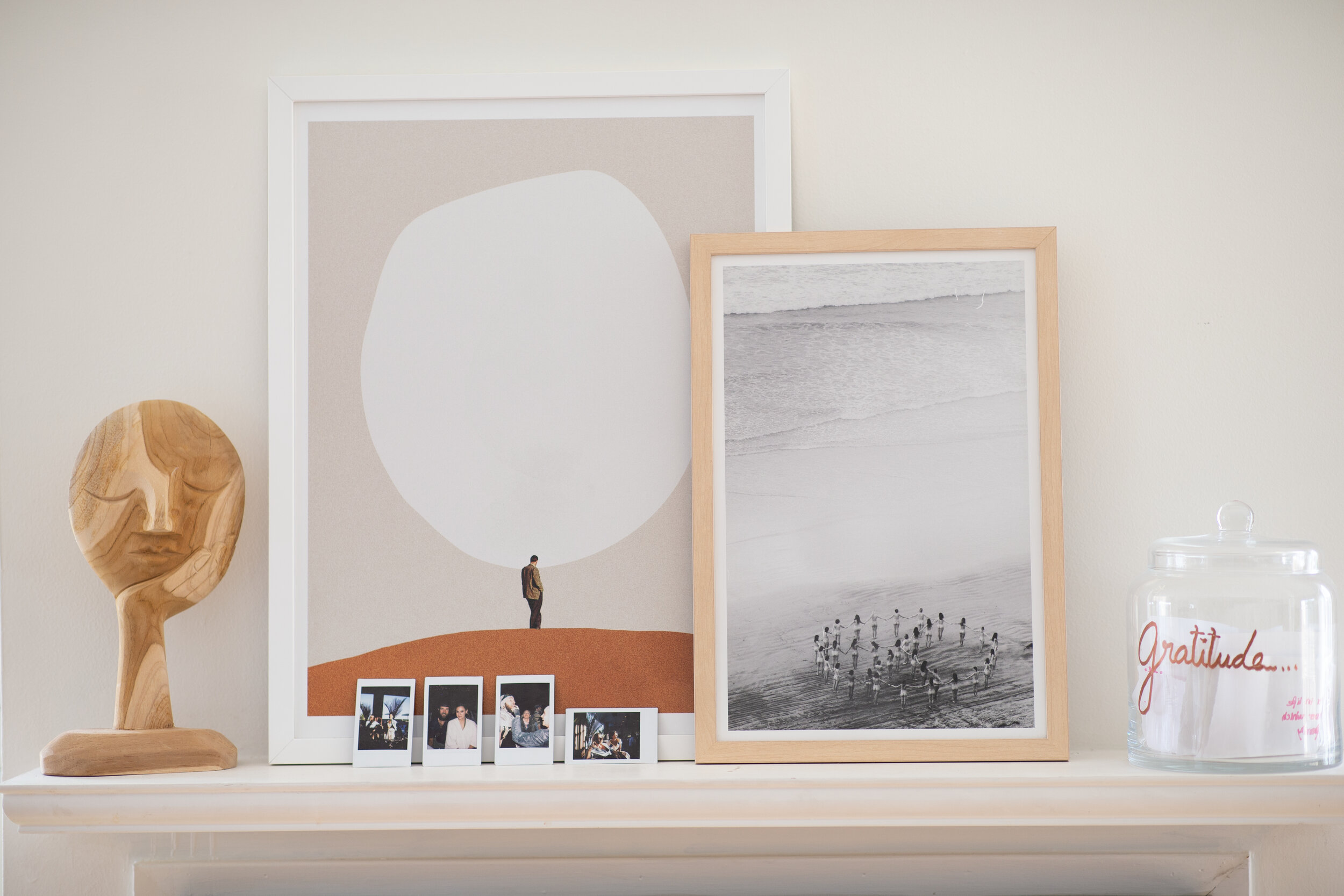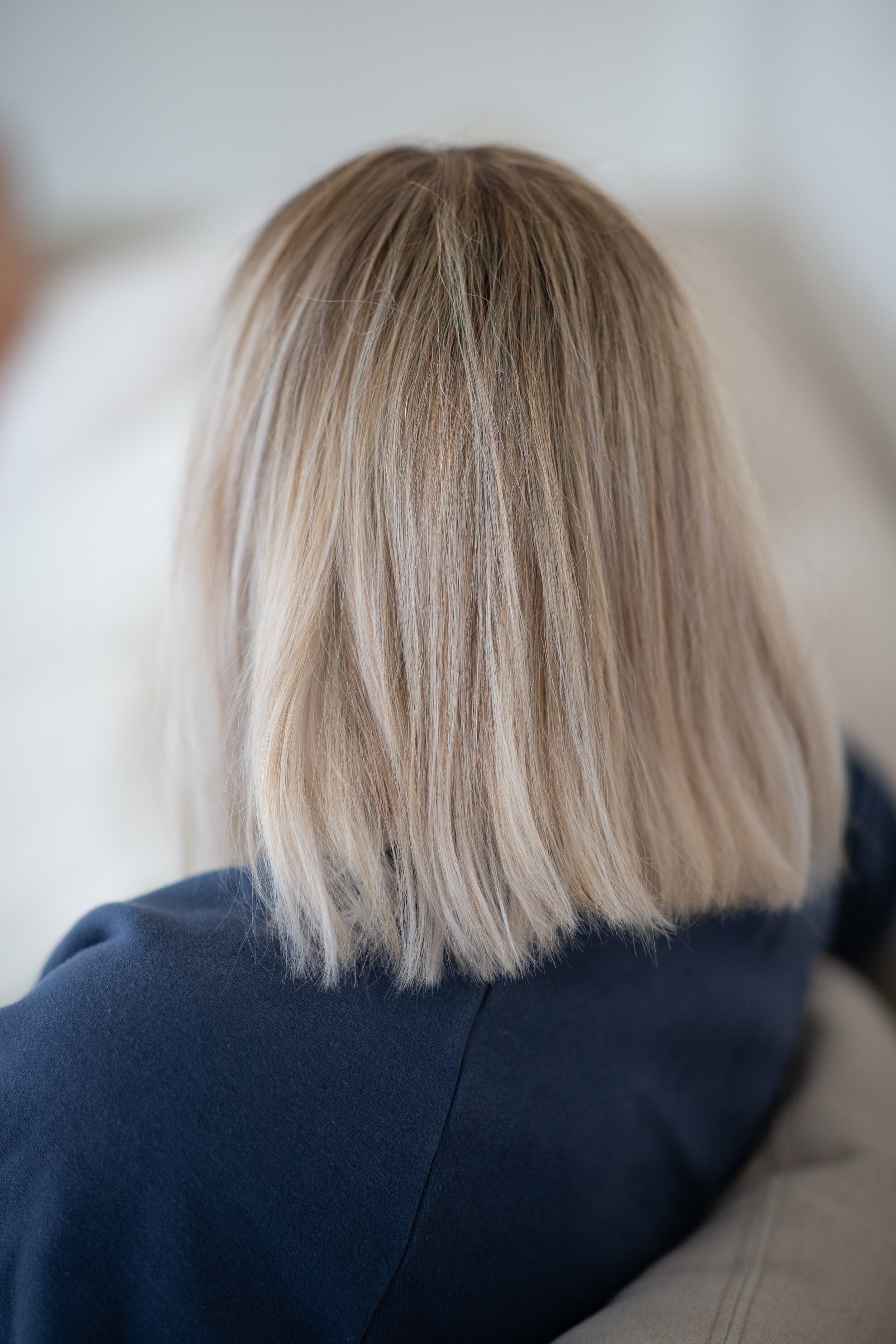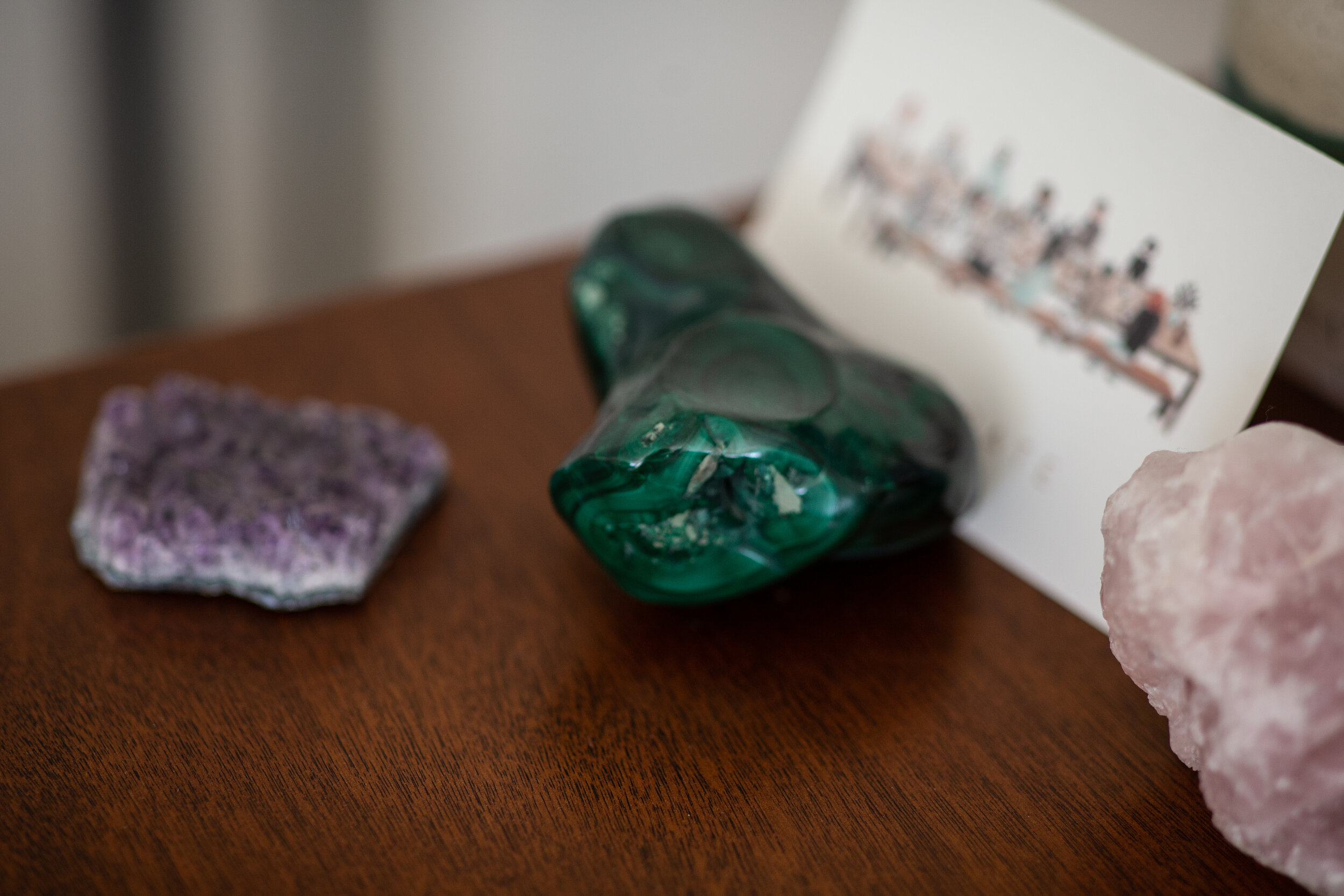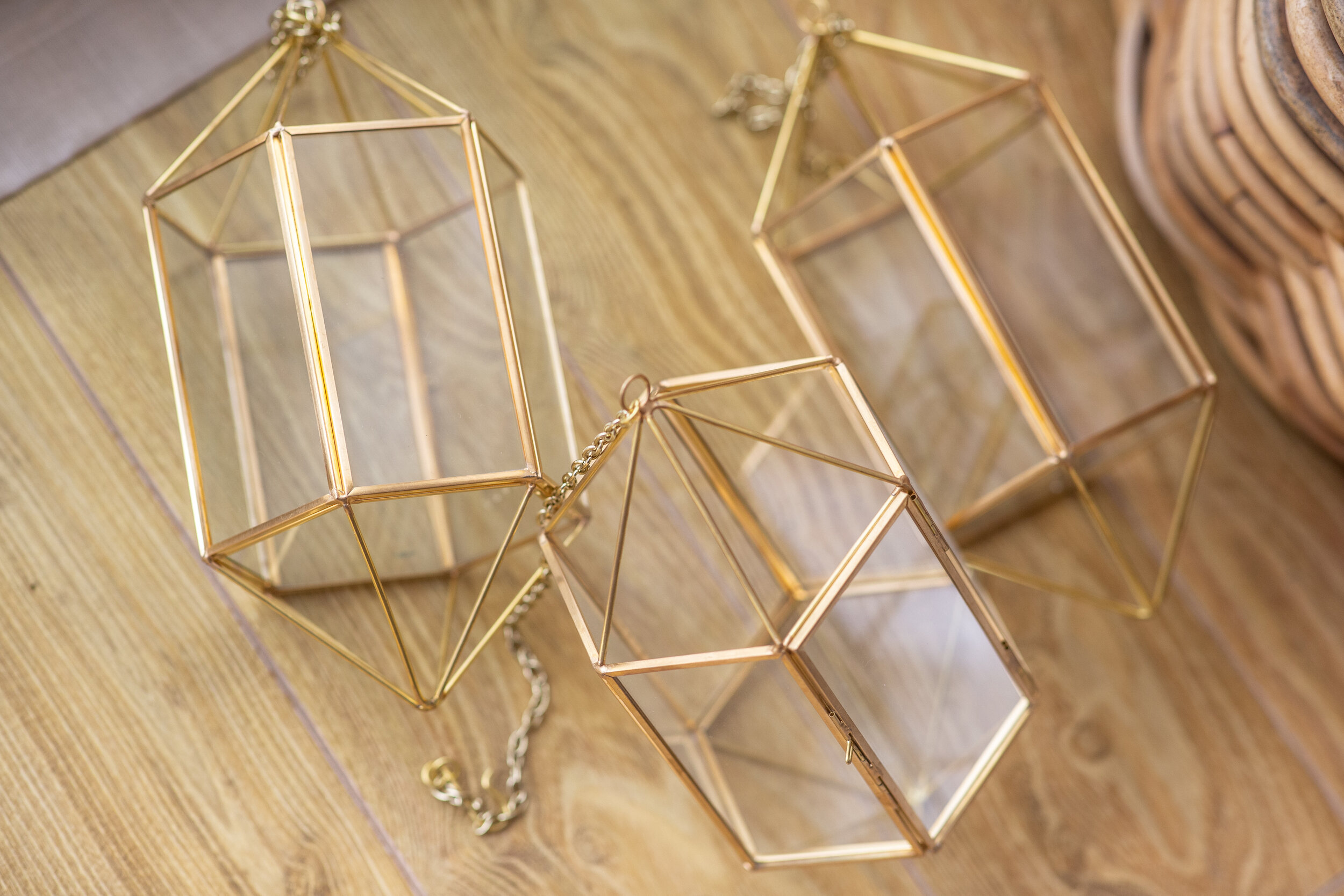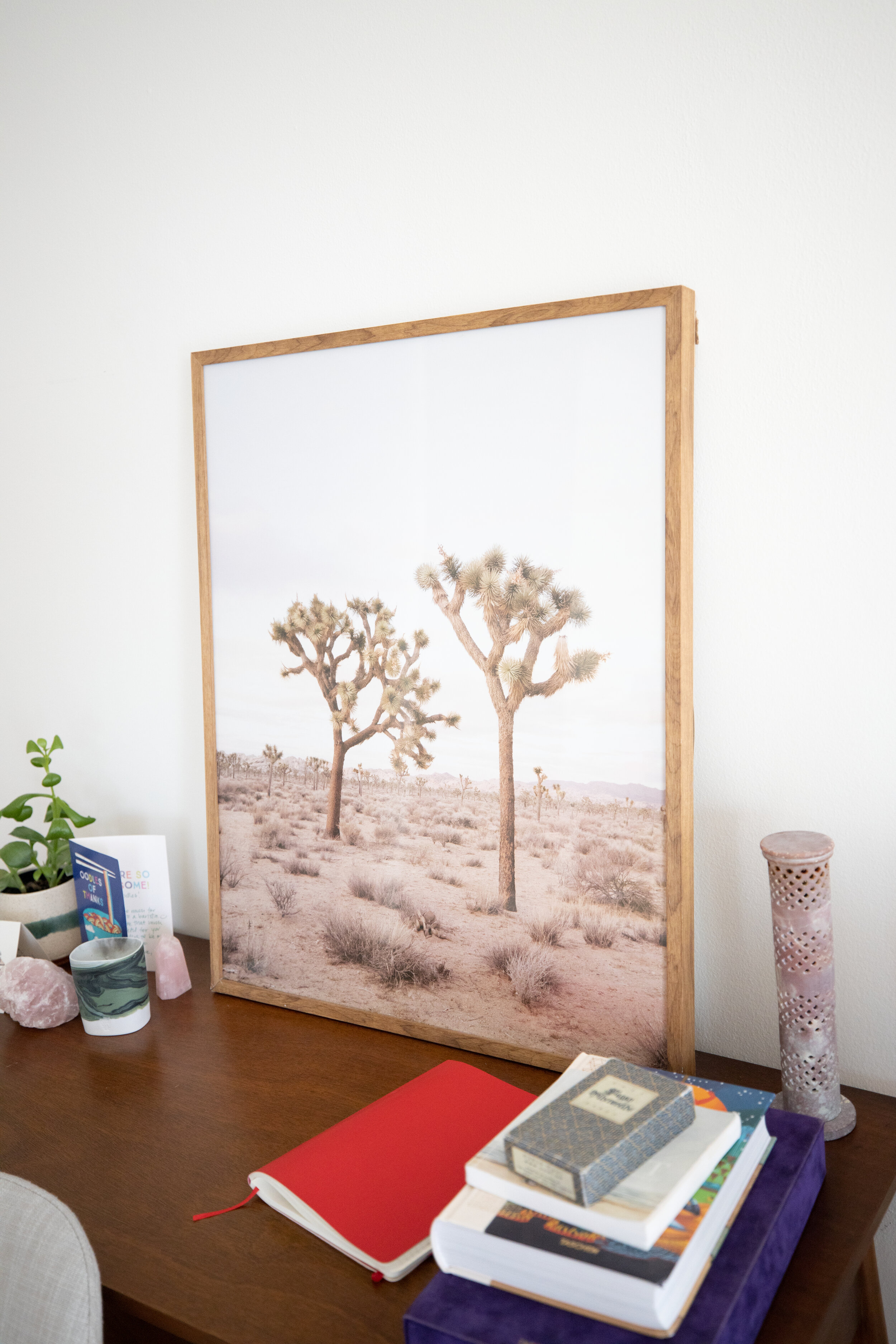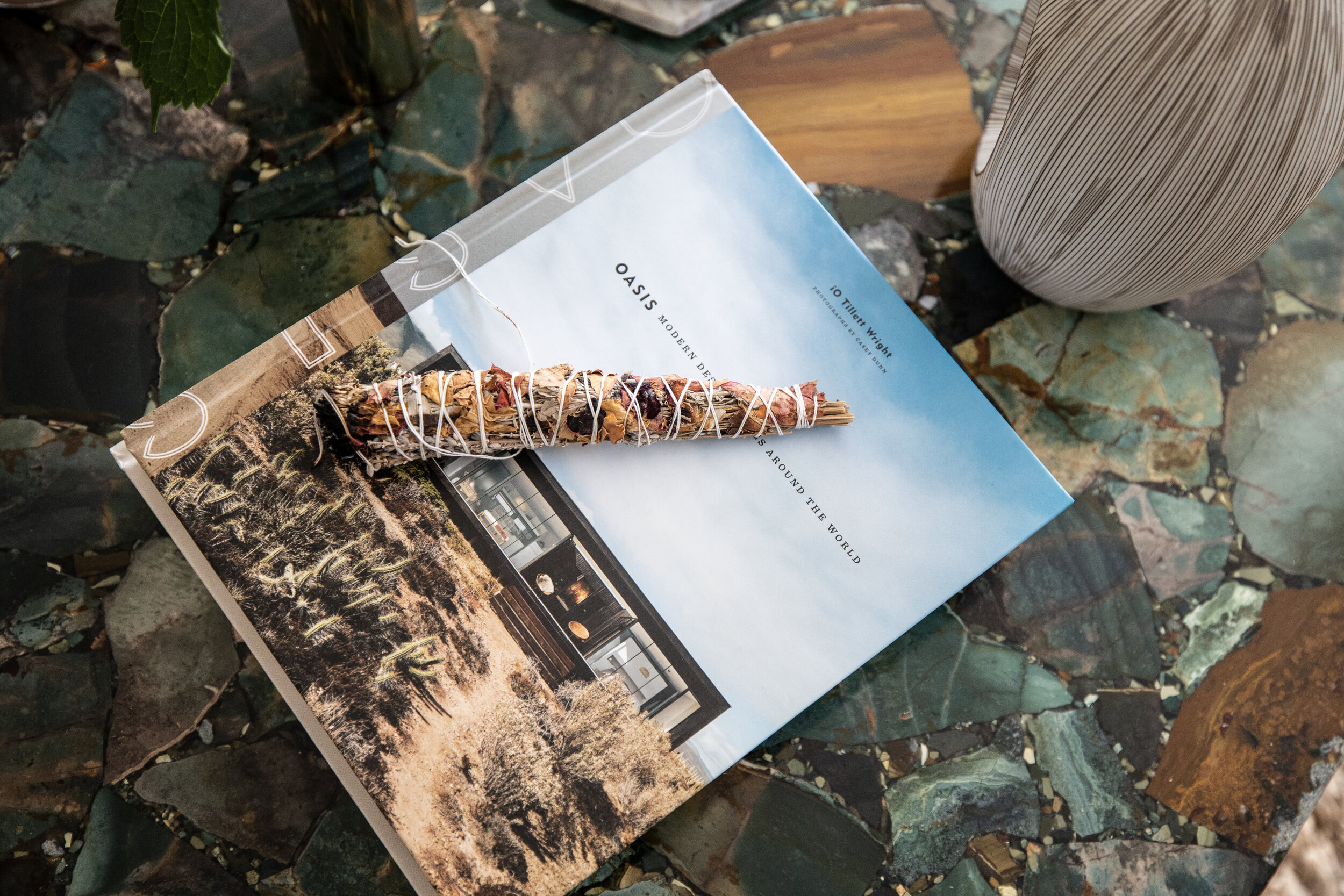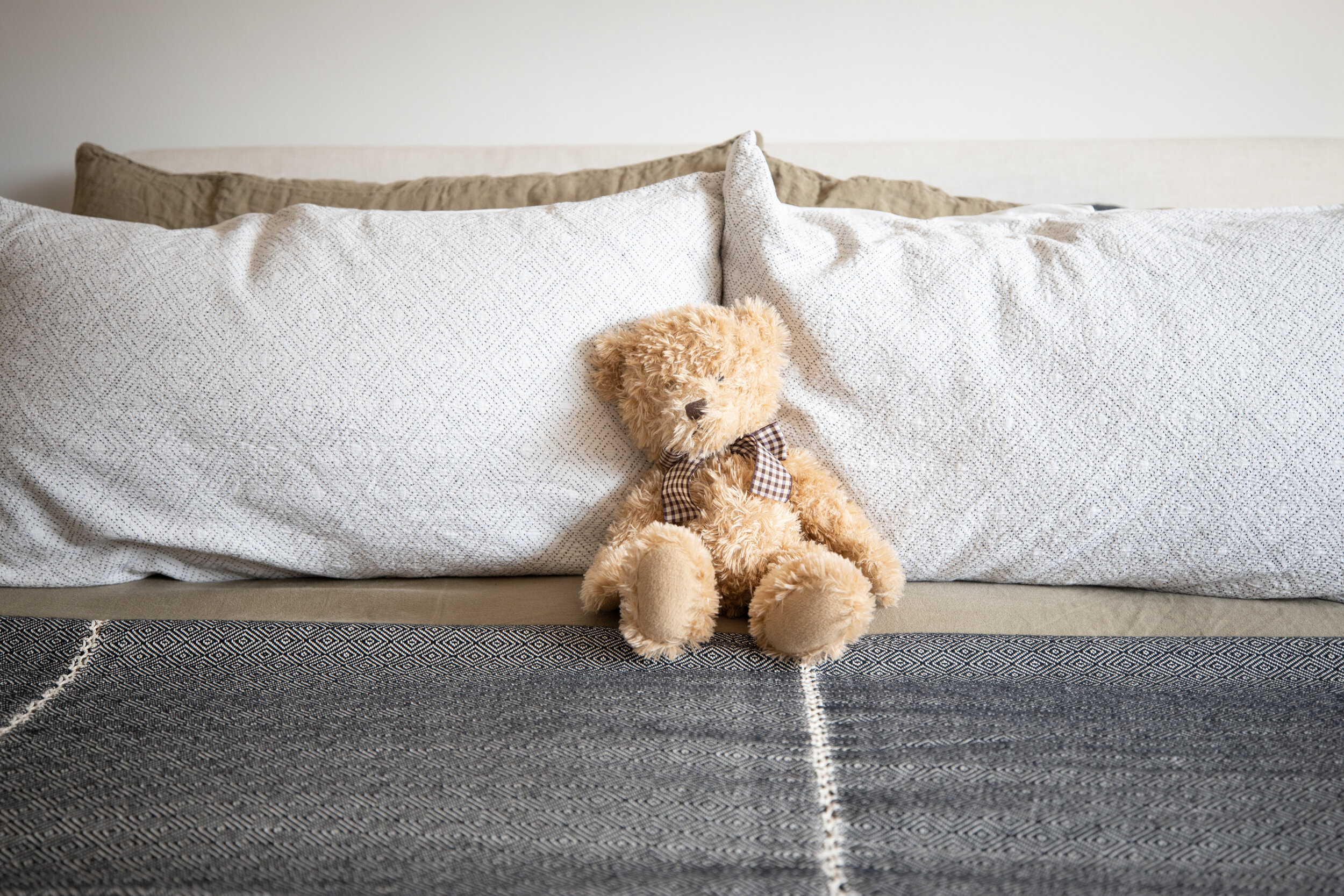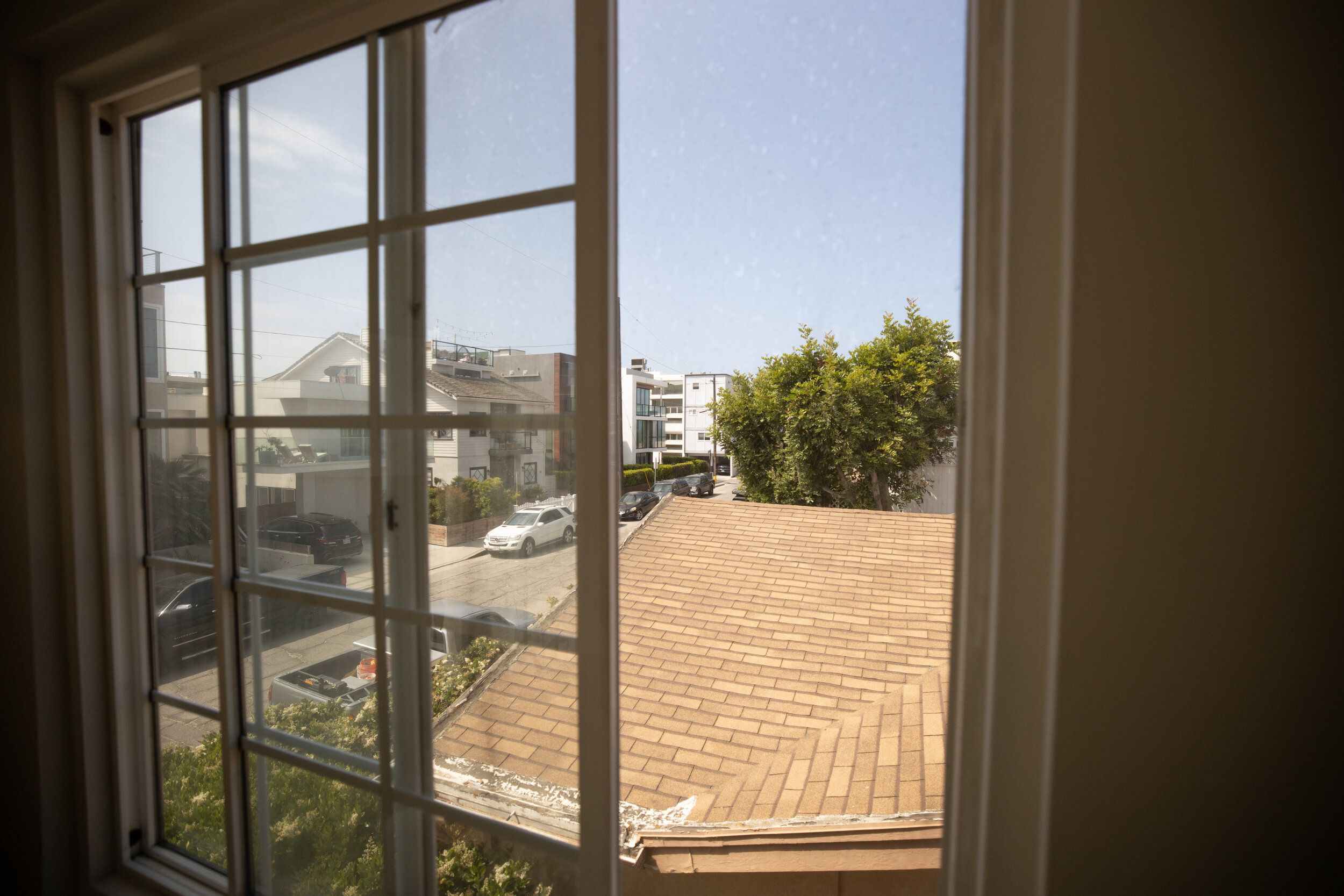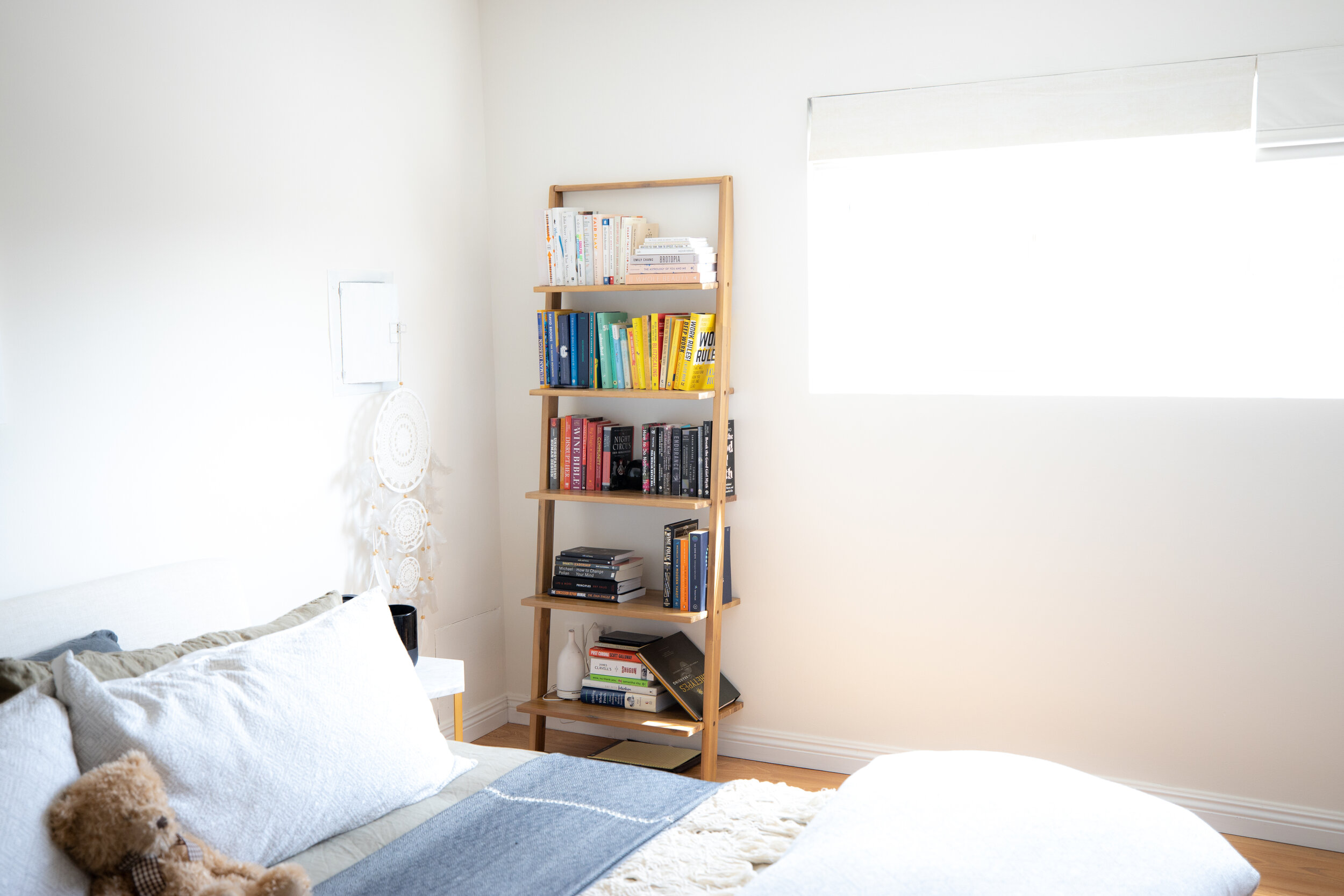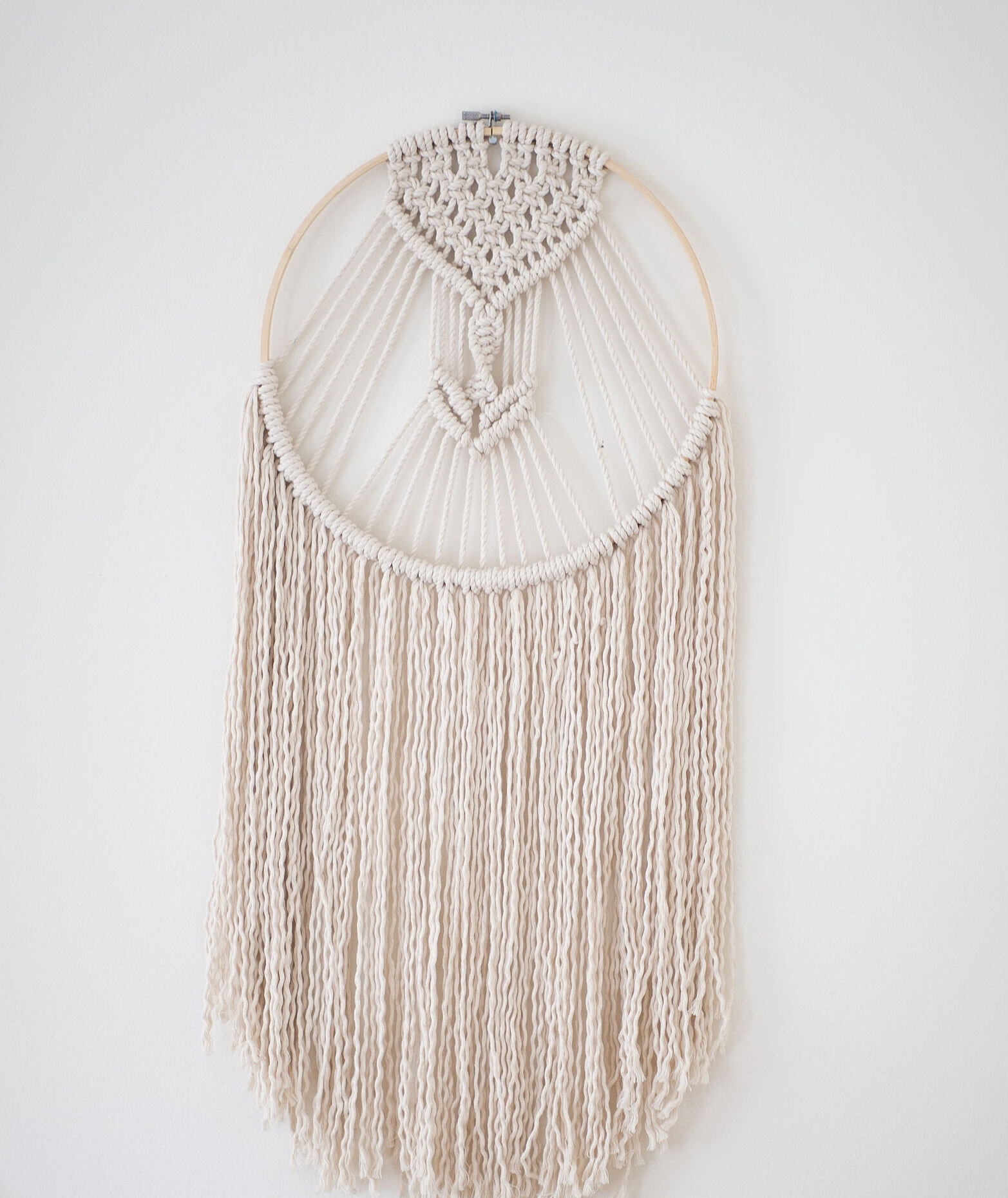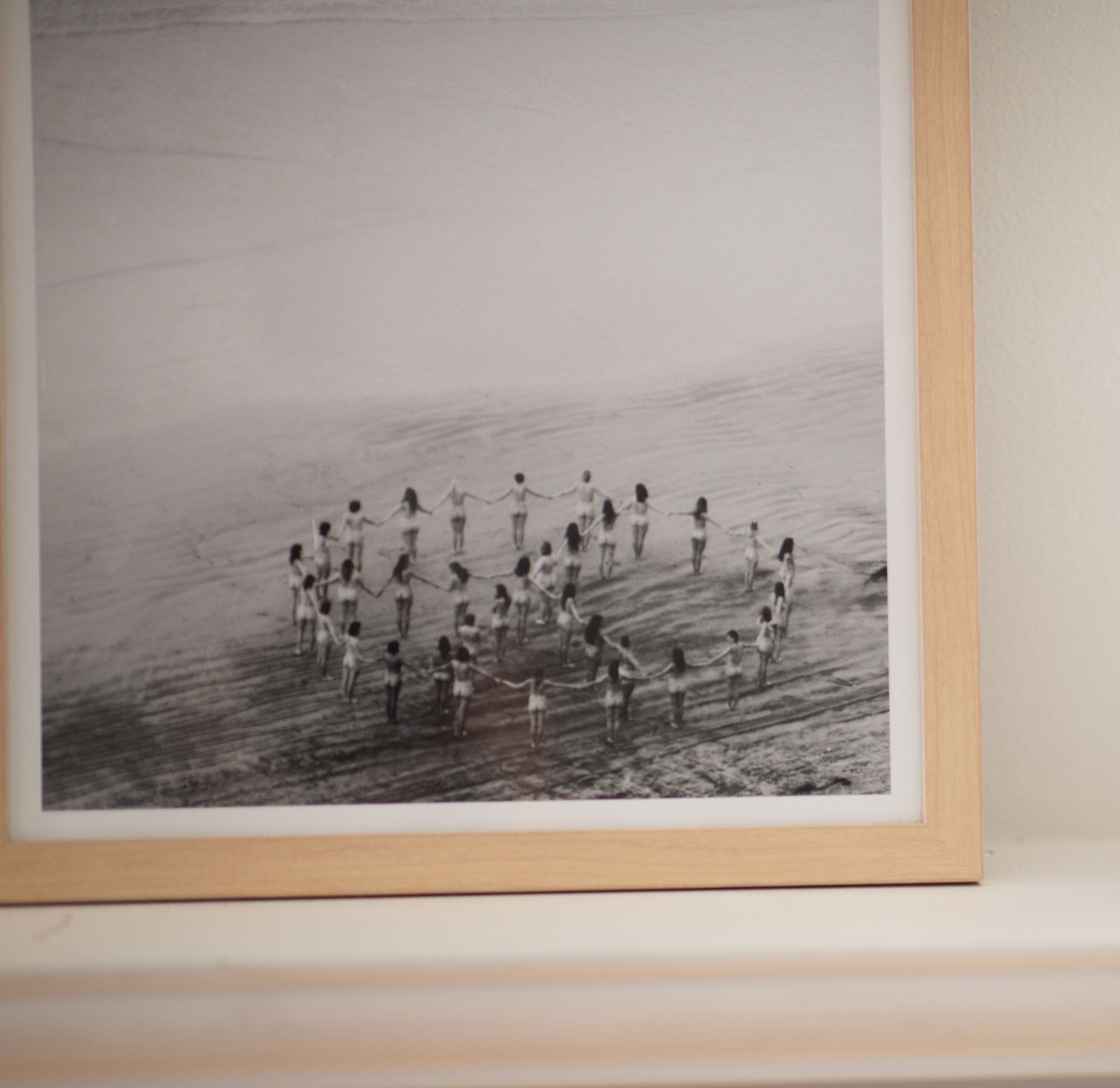Ashley Sumner
The Quilt founder talks going viral and building her self-care start-up company from scratch.
By Lindzi Scharf
Photography by Kate Jones
Few people can say they’ve gone viral on social media during a pandemic. Quilt founder Ashley Sumner is an exception. The entrepreneur created quite a stir when she posted a photo of herself on Linkedin with the words: “I Am a Female Founder.”
She crossed out her gender.
The statement – juxtaposed with an image of Sumner in a power posing posture with leather pants and a stoic expression – took on a life of its own. The post garnered 500,000 likes and nearly 20,000 comments.
“It was the day after International Women’s Day,” Sumner says, seated at a desk in her Marina del Rey home office. “I was like, ‘Let’s throw it on Linkedin,’ because I thought it could be a channel to drive downloads for Quilt. The goal was to get ten downloads. We got thousands. It was crazy. I was like, ‘Other women are saying they’re part of the movement. I stand with Ashley Sumner.’ What do you mean you stand with Ashley Sumner?” She adds, “Somebody told me I should take the image that went viral and make an NFT of it. I’m like, ‘Would anybody want that?’”
Sumner had clearly hit a nerve.
“I was not planning on starting a movement,” Sumner insists. “Katie [Rosman of the New York Times] reached out to me and was like, ‘This is fascinating. Hundreds of thousands of responses and now tens of thousands of women are taking their picture and posting it. This is a movement.’ Her question to me was, ‘What agency did you work with?’”
It was a reasonable assumption given that plenty of the most successful viral strategies are often, unbeknownst to consumers, executed by advertising and marketing companies. However, Sumner insists that her post was the result of thoughts running through her head during a morning neighborhood run.
“For the past couple of years, I’ve been asked, ‘What’s it like to be a female founder?’” Sumner explains. “I’ve never corrected someone, but it feels like a projected identity that’s not mine. When ‘girl boss,’ ‘mom-preneur,’ ‘fem-preneur’ became popular terms – I felt like, ‘Are we doing the thing where we’re commoditizing and creating an image of women that’s not the image of me?’ It feels uncomfortable. I’ve done a lot of deep exploration around my discomfort with labeling, why I think it’s limiting, why it is other-ing, how it could potentially hurt towards equality, the unrealistic expectations.”
To Sumner’s credit, a quick scan of her personal Instagram account reveals she’s made similar declarations on social media a handful of times before her Linkedin post went viral.
She says, previously, “I’d only say it in rooms of ten where I’d be like, ‘Female founder doesn’t feel right. I’m a founder.’ If somebody wants to call themselves a female founder—amen. But that’s your choice. You get to pick.”
Sumner acknowledges the declaration served its purpose. “It was a statement,” she says. “I do like to spark or provoke conversation. So that’s on brand for me, but I ended up being surprised that five words – I Am A Female Founder – [ignited] thousands of responses. The assumptions about what I meant by that was interesting. It brought forward so much from so many different perspectives and backgrounds. Usually, I’m a preambler and overtalker and I write a lot and in this moment, I didn’t and for the first time, it created space for a lot of conversation.”
Shortly after, Sumner was offered a book deal. “Now I have to write a book proposal,” she says with a laugh. “I don’t know what I’m going to talk about…”
SPARKING CONVERSATION
No doubt, she’ll figure it out. After all, sparking conversation is at the core of who she is and it’s how she’s made her living over the last several years. And while Sumner may be reluctant to embrace the newfound notoriety, she’s savvy enough to understand that you can’t buy that kind of publicity.
“I’m a marketing channel for my company,” she says. While she’s appreciative of the attention it put on her start-up company, Sumner says the rules do seem to differ for men versus women. “I’m pretty sure when men get funded, the first thing that’s said to them is not, ‘Let’s build a brand around you. Let’s put you on the circuit of doing this thing while you’re also building your company.’ If their company is successful, then they’re like, ‘How is your company successful?’ [As a guy,] you’re not the marketing channel for your company.”
She adds, “With Quilt 1.0, I didn’t want to do it. If I wanted to be famous, I would have stayed in my pursuance of being an actor.”
SO… WHAT IS QUILT?
In its first iteration, Quilt 1.0 was as a service-fee based website, like Airbnb, that allowed homeowners to list their property and host small gatherings with a focus on intimate conversations and networking. Guests paid $22 to attend with $18 going to the host and $4 going to Quilt. From its 2018 launch to early 2020, Quilt had 1,000 members and hosted over 4,000 events at people’s homes. Then COVID hit.
“It’s been an interesting journey,” Sumner says. “I love the opportunity for people to connect offline, but I’ve gone through a rebirth over the past year.”
That rebirth included Sumner parting ways with her former business partner while plotting Quilt’s pandemic pivot. She and her ten employees had already been exploring what an online version of Quilt might look like and initially hosted Zoom meet-and-greets, but Sumner found that the conversations were missing that initial spark and that many people opted to keep their cameras off. Sumner then spent much of 2020 glued to social media and concluded there was a void in the market when it came to true, honest, soulful connection in the online space.
She set out to create the solution: Quilt 2.0, a free audio-based app that hosts hourly interactive conversations that take place in real-time surrounding topics like self-exploration; queer wisdom for ecological transformation; Buddhist rituals for power, beauty, and altruism; breathwork; guided meditation; and manifestation. Think Clubhouse, but with an emphasis on wellness and self-care.
“I think of Quilting like meditating,” Sumner says. “You wake up and you meditate. It becomes your daily practice and it helps connect you to yourself and thus helps connect you to other people. But meditating is this practice that you do alone. Quilting can be a daily habit – instead of going to Instagram and doomscrolling. Quilting 1.0 versus Quilting 2.0 is the need for frequent connection. With Quilt 1.0, somebody may have gone one time a week. Somebody may have gone one time a month—and they’d get into a home and they’d have this magical conversation, but then everybody would go off into the world and be like, ‘That was a beautiful moment.”
With much of the world in quarantine, Quilt 2.0 provided a safe space for people to convene online and share meaningful conversation. “I wanted a sense of deeper connection,” Sumner says of the app, which was built in the summer of 2020, piloted with TestFlight by the fall, and unveiled in January of 2021 thanks to a $3.5 million round of funding led by Mayfield Fund.
Notable Quilt guests have included Brittany Snow, Grace Harry, Questlove, Tallulah Willis, Sophia Bush, Lily Cornell Silver, Ryan Weiss, Jae Rae, Pamela Bell from Mental Health Coalition, and Dr. Jessica Clemons.
“I just want to make the online world cozier,” Sumner says, sharing that she hopes that Quilt can be “a place you can go where it feels good and it’s accessible at your fingertips no matter where you are.”
In honor of Quilt, Sumner recently created branded sweatshirts that say “Emotional Support” and hats that read “Crying is cool.” “I do want physical manifestations of Quilt,” she says. “The love language of Quilt is gifting. We just keep gifting things to community members so that they have something tangible that can be in their home. Maybe the next thing will be a weighted blanket.”
THE GIRL BEHIND THE APP
In many ways, Quilt is synonymous with who Sumner truly is. She’s as vulnerable and honest as the users who frequent the app. For example, she says, “I actually have fake glasses because sometimes I just want that connection to myself. I’ll put on fake reading glasses as a way to feel safe. I have a teddy bear in my room. As an adult, I think it’s important to still have these things that bring comfort or bring connection.”
And like many within the Quilt community, Sumner spent her twenties and the last several years soul searching. As a musical theatre major at New York University, Sumner was surprised to find herself on a very different path post-college. “I really thought I was going to be a performer,” she says. “When I moved to L.A. in 2015, my friends and family were like, ‘Oh, you’re finally doing it?’ I was like, ‘No, no.’ I came here and I started a tech company.” While acting is no longer an aspiration, Sumner says, “People I run into are like, ‘I think you’re going to go back to it.’ I could see myself starting a theatre company, a non-profit, or a children’s dance studio. I love making sure people have the arts in their lives, but I’m not gunning to audition for Broadway again.”
THE MATCHMAKER
Upon college graduation, Sumner’s friend from musical theatre had started working for a matchmaking start-up and invited her into the mix. “This was pre-Tinder,” Sumner explains. “We hadn’t normalized online dating yet. Everybody had a secret Match.com, JDate, or EHarmony account, but nobody would admit it. We had to sign ridiculous contracts that said we would not say we were anyone’s matchmaker. There was a lot of shame around needing help to find love, which was part of the allure to me.”
However, Sumner’s initial introduction to the profession was on the other side of the desk. “My friend reached out to me and was like, ‘Can I set you up on a blind date?’” she remembers. “I realized in that moment that I’ll say yes to almost anything at least one time. So I went on a date with this person and I dated him for years. We were such a beautiful match and I fell in love with this idea that somebody thought of me for someone when I was busy auditioning and trying to figure out my life. I got to know the founder of the company and I was like, ‘Can I bring you more people to find love? I’d rather make money this way while I’m auditioning for Broadway rather than being a bartender.’”
Sumner spent a couple of years, she says, “meeting as many people in New York City as humanly possible, convincing them that matchmaking was cool.” She adds, “I got so intimately close with these people who were twenty-five to sixty-five years old telling me their entire life story and who they wanted to meet. I learned I had a knack for it.”
Sumner then ran her own matchmaking business from 2010 to 2014 until she turned her sights on a different form of connection.
THE MOVE
From there, she took a position overseeing memberships for NeueHouse, a private social club that provides workspace and events for young professionals. The New York-based company planned to open a space in Los Angeles and Sumner jumped at the chance to relocate in 2015.
“I was craving time away from New York,” she explains. “I was recovering from a physical injury and the team was like, ‘People love to go to L.A. to heal.’ It was such a cliché. When I got out here, I ended up—this is also such a cliché—but it’s true. I ended up being gifted a trip to Burning Man. I had made an introduction for [someone] that turned into a job. She was like, ‘I’d like to give you a ticket.’ I didn’t really know what getting a ticket meant. ... I went and I stumbled into a talk that one of the Burning Man founders Marian [Goodell] was giving on feminine leadership and the importance of reconnecting humanity to femininity. I started thinking about how we need to use technology as a way to reconnect and to deepen connection in bringing people together because the offline community building that I had been doing from 2010 to 2015 just didn’t feel like enough. It didn’t feel big enough and I felt like I wasn’t truly living my purpose.”
Sumner continues, “A lot of the work that I had done in community building was helping the top ten percent. It was privileged and inaccessible. It was social clubs; it was yoga retreats; it was conferences around the world, which are all expensive. You have to be someone to get in. I was like, ‘That doesn’t feel like the definition of community.’ … I felt like the cultures weren’t always where I felt like I belonged and there was a part of me that was like, ‘I can create an environment where people like me can feel like they belong.’ I thought, ‘Well, now I need to figure out how to build technology.’”
AN ENTREPRENEURIAL SPIRIT
The choice to change careers wasn’t entirely out of left field. Sumner grew up in Pennsylvania observing her entrepreneurial parents. Sumner remembers mimicking their behavior while growing up. “I played office when I was seven; not Barbies,” she says. “I would lovingly steal my mom’s expensive watch and I would set the whole thing up. She would come back from work and she’d be like, ‘Who are you?’”
Sumner’s father is in real estate while her mother worked for years in advertising before transitioning to real estate as well. “Both of my parents have always only ever worked for themselves,” she says. “They had the flexibility and the freedom, so I’ve never thought to have a traditional career working at a company for someone. That never fully made sense to me.”
That’s not to say it was a sugar-coated impression. “They’ve also struggled a lot,” she says. “They’ve gone from having money to not having money – and everything in between. My dad has built up companies. Watching his behavior enduring that, I was always intrigued by what that is.”
HOMEWARD BOUND
In a twist of irony, or perhaps fate, Sumner’s initial concept for Quilt led her to visit thousands of homes within the first two years of the business. But the truth is that Sumner has long yearned for a place to call her own. “Home is a symbolic thing,” she says. “Home has always been this feeling I’ve been searching for. When I was nine years old, we moved and a lot shifted for my understanding of safety. My mom is a single mom. [My parents] separated when she was pregnant with me. I have a brother who is two years older and my understanding of the story is that when she was pregnant with me—my parents were building this home—her dream home. I grew up in this dream home until I was nine. That home is this feeling I keep trying to come back to because I do have such fond memories of that experience.”
Sumner, her mother, and brother then moved to Arizona for a year to be closer to her father. “While they weren’t together, she felt called to have him in my life and so she was like, ‘Let’s explore this new opportunity,’” Sumner recalls. “We didn’t like it. I remember connecting to my mom’s sadness. We all felt off. I remember me and my brother going into my mom’s room and getting on her bed and being like, ‘We can go back. We didn’t fail because this didn’t work. It’s okay. Let’s go back.’ So the three of us went back to the same hometown, got a new home, which wasn’t the home that I was born in, but it felt nice to be back in something that felt familiar and safe around our friends.”
A NOMADIC TIME
In searching for a place to call home, Sumner found herself in so many homes – and yet she’s been a nomad for the last year due to the pandemic.
“I went through a lot of change at the end of 2019 and the beginning of 2020,” she says. “Most people are like, ‘I went through a lot of change in March of 2020,’ which also happened, but I went through deep, emotional [turmoil]. I got out of a serious relationship. I had a co-founder and it was time for her to move on and all these things that were super beautiful and right, but everything that connected me to L.A. was no longer there.”
She moved out of the Silver Lake home she’d been sharing with her then-significant other of two years and began home-hopping through friends, acquaintances, and Airbnbs. “In March, there was a friend who is a founder and he has a place in Tahoe,” she says. “We had no idea how intense the pandemic was going to be. As it was all going down, he was like, ‘Do you want to come up to Tahoe and go skiing?’ When I got there, two things happened—a major snowstorm and the pandemic became consciously serious. So I ended up bunkering down in Tahoe with this person that I didn’t really know and left L.A. I was fine with it because I was ready to let go of some of the pain and the big feelings that had just happened.”
She used the time to brainstorm her next move. “I knew I needed to come up with an entirely new Quilt and I didn’t feel like that was going to happen in L.A. I was like, ‘I’ll stay in Tahoe and I’ll come up with the new Quilt.’”
A weekend trip turned into a three month stay. “I went to Tahoe with an overnight bag and I was there for months without any belongings,” she laughs. “During that time, I realized I don’t need much. I used to want physical things. I grew up where there was a lot of value put on material items and then all of a sudden I went to Target in Tahoe and I bought underwear and two leggings and a couple of sweatshirts and I really like them. It was an interesting thing to connect to for my spiritual practice.”
While building Quilt 2.0, Sumner’s form of self-care became learning to play the ukulele. “In the moment where, ‘Everything feels serious and emotional and I’ve got keep this company alive and I’ve got to take care of these employees; I don’t want to cut their salaries; I don’t want them to be afraid; I want to take of everyone,’ I was like, ‘What’s my outlet?’” she remembers. “I missed creative expression. So I got a ukulele.”
HER FIRST HOME
Sumner returned to Los Angeles and moved into her current home in January of 2021. It was a homecoming in more ways than one. “I used to spend time in this home because a friend of mine’s cousin allowed us to use it when I was doing Quilt 1.0 photo shoots,” she says, explaining she was walking in the neighborhood when she saw a “for rent” sign and immediately realized it was meant to be. “I imprinted on this home. Like in ‘Twilight.’ I’m the wolf and this home is the baby girl. … I had no furniture and nothing to put in it. … This is the first time I’m ever as an adult making a home, so the journey has been a little uncomfortable.”
But Sumner says she’s ready to sit with her discomfort. “I had my astrological chart read a couple nights ago,” she begins to say, then catches herself and laughs. “I really am so many clichés.” She continues, “But she was like, ‘Go easy on yourself right now because Neptune is crossing some transit of something and what it means is that you have the feeling of fog that you can’t see. You’re going through a massive restructuring of how you perceive things, experience things, and what you want your life to look like. Just go really easy on yourself because that fogginess is going to be uncomfortable, but you actually can’t see what’s next for the first time. You need to have the practice of connecting to your deeper knowing or intuition or your gut, your instinct, whatever that is, and allow yourself to be led for the first time without you charging forward.’”
She agreed with the intuit’s assessment. “I’ve been very good at activating the thing that I want and doing it,” Sumner says. “I want this company. I want people to experience it. I’ve been so clear.” For the first time, she’s ready to follow the fog and see where it may lead – both professionally and personally.
“Recreating the company, connecting with my identity, building my home, and building Quilt, I’m in this place where I would love [to meet someone],” she admits. “I cross the street and fall in love. I love people. Like in New York, it was a problem. I was like, ‘I love you, I love you, I love you.’ … I feel like for the first time I’m actually ready for deeper connection, but I’m also so excited about what I’m creating with Quilt. I have a therapy session today. I might talk about what it means to feel ready, but to feel protective towards what I’ve created and the stuff I have going on. I don’t want anything to mess anything up. I don’t know… We’re in a fog.”
HOW SHE LIVES…
“Make yourself comfy,” Sumner says as she takes a seat on her couch, which arrived just one day earlier. She launches into a story explaining the journey to finding her couch. “I was like, ‘I want the coziest couch,’” she says. “Okay, but what does that mean? It’s a big purchase – the coziest couch. So in January, I’m running around sitting on couches anywhere they’d let me in a pandemic. So I go to one store and I get on a couch and I’m like, ‘This is my couch. I love this couch.’ … It came last week. Four months later. I’ve been without a couch.” But they delivered the wrong model and Sumner suddenly found herself in the middle of what she calls a full-blown tantrum. “The couch represented the whole new life I was creating. One friend brought me chocolate cake. The other came over to try to tell me it was going to be okay and help me move it. It was a mess.” Her colleague stepped in and had the couch picked up and Sumner instead picked out this Tiburon couch from Los Angeles furniture retailer HD Buttercup.
THE UKULELE
“I always want to tackle challenging things,” she says. “I have an Ableton Push, which is a really intense music production system to make digital music and I have guitars and saxophones; things that are hard to do well. My mind loves a challenge. Last year, I was like, ‘I just want to play and have fun,’ and in the lightness of playing, I was like, ‘I need a ukulele because every time you strum a ukulele, you’re just happy.’ So I brought that up to my friend and he knew that gifting was my love language. I try to have it not be, but I translate love through a gift. You could wrap a rock. It could be a pencil. It doesn’t matter. So he wrapped it and if you were to ever meet him, you’d know, that’s not his thing. So it was a beautiful act of kindness for him. The progressions are just happy and it’s also really easy. Anyone can learn the ukulele.”
HER LOVE OF MUSIC
“My grandmother was a jazz composer and jazz professor and feminist and activist and she put instruments in all of our hands at a young age,” Sumner says. “Growing up, one of my fondest memories is my mom playing the guitar with songs out of a notebook that her sister, who unfortunately passed away when she was sixteen, wrote in this book. My brother is a brilliant guitarist, so brilliant that in my mind it was like, ‘I’ve got to find another thing because he’s so good that if we’re ever going to do a family band, he’s got it.’ I can play the piano and I was a singer at NYU, so I could do those things, but I was like, ‘If the band ever comes back together, I want to bring something [different to the table].’ I romanticized the ukulele as that.”
HER TATTOOS
Sumner has seven tattoos in total. “Every tattoo I have was planned and executed on the same date,” she says. “I don’t regret any of them.” She recently met a guy who bonded with her over her ink. “This is another cliché story, but I went to Erewhon and I look up and there was this really beautiful person. I was like, ‘Uh oh. That’s a really beautiful person.’ Luckily, I was hiding behind my mask. We kept making eye contact and then I got over to the sushi section and he came around and he was like, ‘Tell me about your tattoos.’ I told him about my tattoos and it turned into this whole spiritual conversation. I made him send me his astrological chart to see if we’re compatible. He’s still in my life. I love him so dearly, but the tattoos—I was like, ‘Why were you so drawn to that one?’ He was like, ‘I wasn’t. I was just picking something to talk to you about. I just was trying to make a connection. I don’t know.’”
RUBY & VIC
“This one is my alter-ego with one of my best friend’s alter-egos,” Sumner explains. “I’m Ruby Stone and she is Vic Harper. They are our alter egos. Ruby Stone wears a lot of leather—probably that picture that ended up on the front cover of New York Times was a little Ruby Stone flex. I put the leather pants on and was like, ‘Are we doing this?’ I put a pin that says ‘Cosmic’ on the blazer. I was like, ‘Ruby put the pin on.’ I’m a cancer as my sun sign, so ruby is the stone of cancer. As a young child, I would go to my mom and be like, ‘I want ruby stone jewelry,’ and she’d like, ‘Who are you? You’re four.’ I always loved rubies. So with my friend, the conversation would oftentimes come up that I’m a cancer crab, so the first nickname I got was LC, which was ‘Little Crab.’ Little Crab has the teddy bear and the ballet slippers and the inner child. Then when my big personality would come out and I’d want to have a lot of fun, I’d be like, ‘Everybody we have to have a lot of fun now,’ she’d be like, ‘That’s not LC. That’s something else.’ So that’s how Ruby Stone came about. And I started calling her Vic Harper. So we both have the tattoo. That’s a fun one.”
THE SUN
“A woman did it on the east side,” she says, referencing sun and moon tattoos. “The sun is cancer, which is nurturing and caretaking and home and family and emotive and feelings and water. Aquarius is a humanitarian, a futurist, but detached. It’s an air sign. It’s like, ‘I don’t want to talk about my feelings. I’m going to turn my feelings into thinking and then I’m going to philosophize on it and not go there.’ My basic identity is this thing, but my sense of who I am when I’m alone and with myself is this thing. They feel so at odds with one another that I’m constantly figuring out how to integrate the two and so that’s why I got those.”
THE SUN, THE MOON, AND ALL THE THINGS
“I want all the things, all the time,” she says. “That’s my handwriting. I was having a stressful work day. My office was in downtown Los Angeles. I crossed the street and went into a tattoo shop with a piece of paper and was like, ‘Can you put that here?’ You can tell the S is pretty far away from the rest of the letters.”
THE W
“This is a W I got in 2016 right when Trump was elected,” she says. “I was in New York City with a bunch of women and we didn’t know what to do and we were worried about women’s rights and I was like, ‘Let’s create something to allow ourselves to stay connected to ourselves.” We all went into a tattoo shop on Bleecker Street, my mom included, and we all got a W.”
AWARE
“There’s a festival down in Careyes, Mexico that my friend Lulu Luchaire puts on,” she says, while showing off a tattoo she got in 2017 that says aware. “When I got there, I was like, ‘I’d get a tattoo if I could get it for free here.’ I have no idea where that thought came from and everybody was dancing and partying and sipping Mezcal on a beach. I look over and there’s a beautiful Mexican man named Manu [Mard]. Tattoo Manu. He’s a famous tattoo artist and I went over to him and was like, ‘Will you give me a tattoo?’ He was like, ‘Yes.’ So there’s a picture of me laying down with him tattooing my hand and I’m pouring Mezcal in his mouth. It’s not my handwriting. I ran around the party and had everybody write the word aware and I’m actually pretty sure that this is Ricki Lake’s handwriting. I’d have to ask her, but I think she got the winning signature that’s now on my finger.”
ESPRESSO MACHINE
“I had two stints in Tahoe last year,” Sumner says, explaining she went all the way back to Los Angeles to pick up her espresso machine. “I really, really missed my espresso machine. I have pictures of my car where it’s in this front seat with me—strapped in. The espresso machine went to Idyllwild, Joshua Tree, Paso Robles, Tahoe, and Napa because I couldn’t get coffee anywhere. I was like, ‘I’m not going to recreate my company without a great latte in the morning.’”
THE PHOTOGRAPH
“That was a gift to myself,” Sumner says. “I spent time finding myself in Bali. I’m like an Eat, Pray, Love chick. I didn’t know how I was paying my bills for a while, so when we closed a round of funding, I was like, ‘Oh, I get a salary now. That’s great.’ Previous to that, I was doing a co-working pop-up at Platform in Culver City. Downstairs was a pop-up for House of Spoils’ [fine art photography]. I would walk by this photography place and I would see women in leather on motorcycles on a beach in Bali. The person that gets the tattoos and has a nickname Ruby Stone was like, ‘Fuck yes.’ It was feminine, but powerful. So that was my gift to myself when we closed.”
POST-ITS: A LOVE STORY
“I am turned on by post-it notes,” she jokes. “At all times, I have post-it notes on me. When you’re starting a company, there’s so much strategizing and Quilt’s mission is so big that I kept having these profound moments, so I’d want it on a post-it note. … By the end of the week, there’s post-it notes all the way around [my desk].”
THE CRYSTALS
“When you move to Venice, throw a rock, hit a crystal,” Sumner jokes, although she says she’s had a fascination with crystals since she was a teenager. “When we were younger, my brother got into laying crystal grids and building orgonites – where you take organic and non-organic material to create an energetic semi-conductor. He was making these resin, metal, organic, and non-organic shapes. He’s such a special person. He wanted to protect me and my mom, so he would make them in these cylinders. Then he would drop them in our purses. I’d be like, ‘Why is my purse so heavy?’ And there would a crystal in there. They would be everywhere. That was him making sure that we were safe.”
THE CRYSTALS: PART TWO
Her various crystals represent different moments and desires in her life. “I first fell in love with rose quartz when I was learning about crystals,” she says. “It was my own self-love journey. And the sodalite was for when I started [doing public] speaking. I was getting asked to speak on a lot of stages. So I’d have the sodalite stone in my hands. Speaking comes naturally to me, but I had to find my authentic voice. Going from being performative to being comfortable with authentic expression. Amethyst is my mother’s stone—it helps with addictions. I love this malachite one. This one kind of reminds me of the paperweight that sits on the desk of a man with a cigar.”
HER RINGS
“I just got myself this,” she says, showing off a vintage ring she purchased from Love Adorned in New York City. “Every time I raise capital, I buy myself a gift. I am so grateful and so shocked that we raised capital and closed all the money at the end of last year. I’d just gotten back here and all of my jewelry was stolen [in New York]. I’ve been rebuilding, so I got this for Valentine’s Day in 2018.” Sumner also wears a chunky gold ring by Miansai on the middle finger of her right hand. “I’m trying to connect back to my funky side,” she says. “I was a hip-hop dancer growing up. Lately, I’m wearing hats and I’m just trying to connect to my funky side again. I felt like this was funky. Men would wear it. It felt like an old school eighties ring that a man would wear, so I got this.”
HER Q RING
“The [Quilt] team had this made for me with a Q on it as the fundraising closed [for a new round of capital],” Sumner says, holding up a silver ring by Los Angeles jeweler J. Hannah. “This was their gift to me.” She says that friends, colleagues, and potential suitors all embrace her love language. “As soon as I start dating someone, they find out that my love language is gifts, so then I start getting a lot of gifts. My best friend was like, ‘I think I need to start saying my love language is gifts.’ I was like, ‘It actually is my love language.’ I really have this love language. There are two things that a lot of people I’ve gone on dates have acknowledged. They’re like, ‘I wish you looked at me the way you look in front of a present before you open it or in front of a pizza before you eat it.’ I’ve been told that a lot and they don’t know each other, so I’m the only common thread there. Like twenty people I’ve dated have said it.”
THE JUMPSUIT
“This outfit came with me last year [to Tahoe],” she says in a jumpsuit by Los Angeles label Ozma. “I got this living in Silver Lake. The designer Heidi [Baker] used to open her home for hosting Quilts. I was like, ‘What clothes do I want to wear for an entire year? What won’t I get sick of?’ This was one of [the few outfits that came with me].”
THE BURGER SHIRT
“I’m a recovering vegan,” Sumner jokes, holding up a shirt by Wildfang. “My mother was sick with heart disease when I was twelve and so I’d learned that not eating meat could help her heart, so I became obsessed with not eating meat – thinking maybe she would eat less. That didn’t happen. She just had to then cook two meals. So I actually gave her more stress. I stopped eating meat around twelve until I was twenty-seven. Then I dated somebody in my early twenties, the guy that I met through matchmaking. He had testicular cancer and so we went super vegan and plant based as part of his healing journey. I dealt with chronic body pain from seventeen to thirty and so part of me learning about healing my body was also this avenue. The irony is that I got really sick from not having all the nutrients that my body needed. When I moved [to Los Angeles] in 2015, I was trying to recover and I started having dreams about burgers. So I got the most humanely sourced possible burger meat I could find and I cooked a whole package of burgers – four burgers. Thus began my feeling better.”
THE NEW YORK TIMES
“When the piece in the New York Times came out, my mom was like, ‘I knew you were going to be famous,’” she says with a laugh. “After the New York Times piece came out, we were like, ‘Let’s Quilt about it,’ because we had all these people coming on wanting to talk about it. A woman in the community who had always worked in technology, but was a new founder asked me, ‘When did you know that you were a founder?’ Pragmatically, I’d say, ‘When your company is incorporated.’ But I surprisingly got emotional. I started almost crying and I was like, ‘I think I was born this way.’ As somebody who wants to create things from scratch, it’s an identity that I’m comfortable coming out with where I never really felt comfortable attaching myself to an identity before.”
THE BALLET SLIPPERS
“These are my first ballet slippers,” Sumner says. “My mom just found them and mailed them to me. She was like, ‘I thought you should have these.’ She put me in them when I was three. I have these pictures of me with way too much make-up on. My mom came into a Quilt and all the Quilters were like, ‘Tell us about Ashley when she was younger.’ So the story of me dancing came up. So she started sending around the picture to Quilters and mailed me the ballet slippers.”
THE GRATITUDE JAR
“One of the last ever [in person] Quilt gatherings was in my home in Silver Lake on Thanksgiving [in 2019],” she says. “We packed seventy women into the home, the backyard, the porch. This woman had recently become a widow and she learned about Quilt as the place to come to feel safe with other people. I will never forget it. She shared and she was the brightest, happiest, most joyful human being who was so in her feelings. We did a classic Quilt circle and spoke. She stayed afterwards and we talked for hours. She was like, ‘I just want to dress up and have fun.’ So we did this whole holiday fiesta for her. The theme was velvet, sequins, leather, whatever. She brought this jar and wrote ‘gratitude’ on it. She presented it with this big, gold bow. We put it out and all of the women wrote something they were grateful for and that’s what all of those notes [inside of it] are. They’re gratitude notes.”




